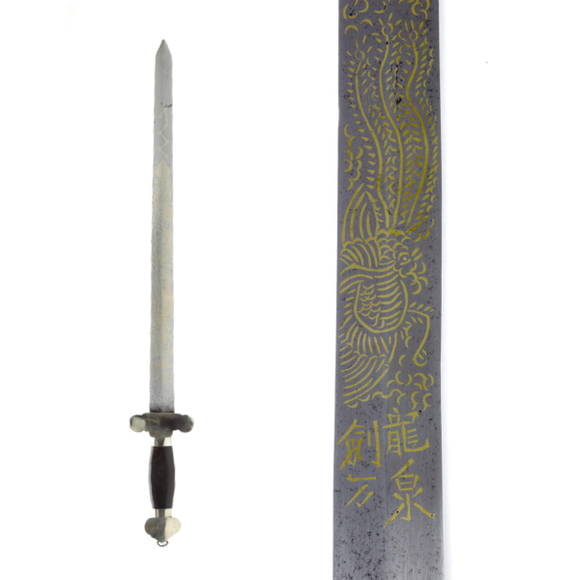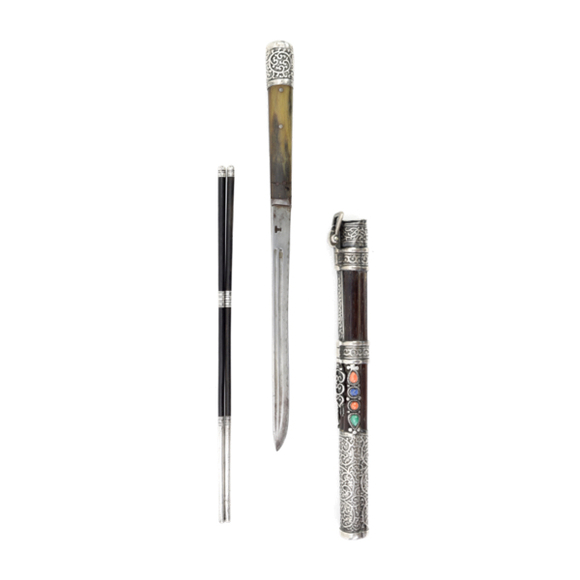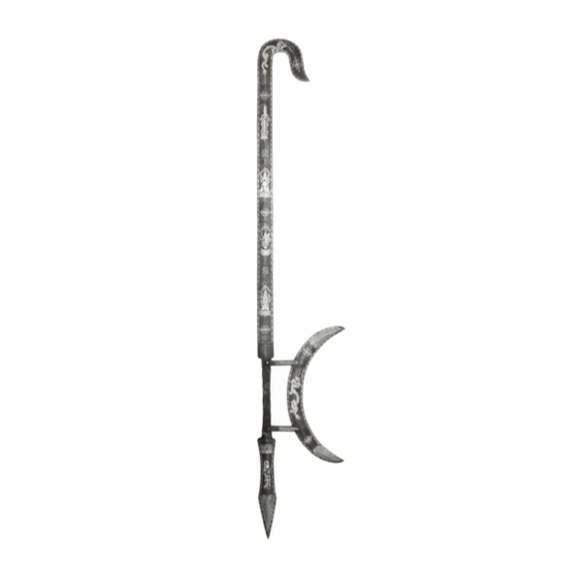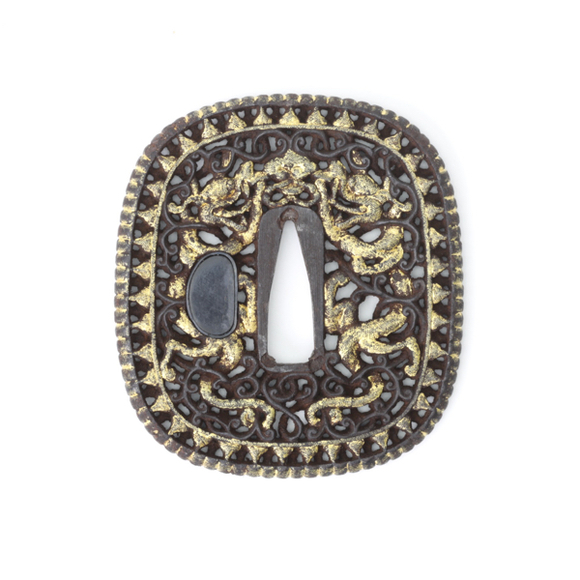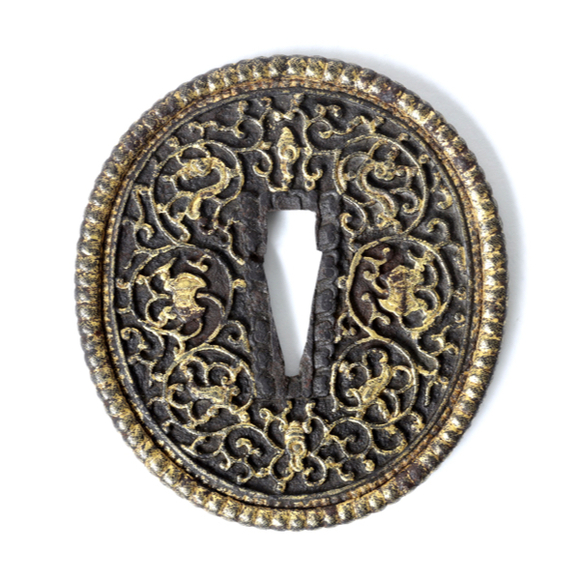A Chinese shortsword made by a well-known Longquan maker.

Sheathed 70.5 cm
Sword 68.2 cm
50.4 cm
Base 5.5 mm
Middle 4.5 mm
5 cm from tip 4 mm
Base 30 mm
Middle 26 mm
5 cm from tip 24 mm
671 grams
12.5 cm from guard
(hilt side)
Iron, steel, brass, wood, copper, stingray skin, báitóng, cotton, silk
Northern China
Possibly Manchukuo
Second quarter of the 20th century
From a European collection
Description
An interesting short jiàn of the later period. It has a blade with strong, Western-style ricasso before the blade becomes ridges and double-edged. The blade has seven brass stars inlaid into it, representing the Big Dipper, a significant constellation in Daoism. It is not sharpened, except for the point.
Hilt with wooden grip and cord wrap, the mounts are executed in heavy brass with a stylized bat-shaped guard and large pommel. A hole in the guard once held a button that lowered a little lip that caught on the base of the scabbard. This feature also appears on the Japanese guntō, military swords carried by the Japanese imperial army.
The scabbard is covered with green stingray-skin. It has two brass suspension bands with suspension loops, without the suspension bar that Chinese swords tend to have: a feature also seen on the Japanese tachi. Scabbard mouth- and endpiece are both of báitóng.
Connected to the pommel is a silk tassel reminiscent of those worn with the Japanese guntō.
Condition
There is some damage to the scabbard's end, with some material missing. All mounts are secured with a little screw, but there is no hole for a screw to hold the final mount, which means it was once a little further up the scabbard. That portion is now lost. The blade, however, shows the seven stars evenly spread, so the tip cannot have been much longer, if longer at all.
Historical background
This style of sword was designed by Mǎ Liáng (馬良), a.k.a. Mǎ Zi Zhēn (馬子貞, 1875-1947). A notable Hui warlord of the Ma clique, a group of Hui who dominated Qinghai, Gansu and Ningxia from 1919 until 1928. By the 1930s, they allied with the Han-led Kuomintang in their then capital, Nanjing.
Mǎ Liáng was a prominent figure in the Guóshù (國術) movement of the revival of traditional Chinese martial arts. He was connected to the Central Guoshu Institute (中央國術館) in Nanjing and authored Zhonghua Xin Wushu (中華新武術) or "New Chinese Martial Arts" in 1917 as well as a manual on stick fighting titled Gùnshù Kē (棍術科).
In 1952 Chiang Kai-shek offered Mǎ Liáng the post of Commander-in-chief of the 103rd Route of the Kuomintang army, which he accepted. He lead them into the Kuomintang Islamic Insurgency where he inflicted heavy damage on Mao Zedong's communist troops.
The sword was mentioned in a 1931 sword manual titled Qīng píng jiàn (青萍剑) by Zhāng Xù (張序). It contains detailed instructions and several diagrams on the construction of swords exactly like this. The author writes:
"The recently by Mǎ Zi Zhēn designed new type of sword is admirable and practical for use.
Which is why I include it in this book."

新製劍及劍匣圖
Xīn zhì jiàn jì jiàn xiá tú
"Newly made sword and scabbard diagram"
It shows this type of sword, including the distinctive guard with the scabbard catch in the guard that is operated with a button, Japanese guntō style. Also, notice the scabbard bands with circular rings and cutouts in the scabbard mounts.
There is another such sword in the Beijing Military Museum. I photographed it on a 2005 visit to the place. It does not appear to have a ricasso but otherwise is in very similar mounts.

A similar jiàn in the Beijing Military Museum.
No description was provided.
Photo by author, 2005.
The sword appears again in the Jiànshù Kē (劍術科) of 1933 where it is said to have been 10 years in development. The book describes several jiàn from ancient times to the Republican are. This design was considered a major upgrade over earlier designs due to the substantial, forward quillons that could catch an opponent's blade.


Two illustrations from the 1933 Jiànshù Kē.
Showing the construction of this jiàn, and it being used in a duel.
References
Thanks to Sunny K. P. Lam for pointing this out to me. He also provided translations and background in personal communication.
Diagrams from: Zhāng Xù (張序); Qīng píng jiàn (青萍剑). Nanjing, 1931 & Jiànshù Kē (劍術科). Nanjing, 1933.
Qing imperial guard attributions
The style of the hilt and scabbard mounts appear on two swords mentioned in Alex Huangfu's book Iron and Steel Swords of China. One is described as Lánlíng Shìwèi jiàn (蓝翎侍卫劍) or "Blue feather Bodyguard straightsword" of the late Qing dynasty. Another on the next page is described Huángshì Shìwèi jiàn (皇室侍卫剑) or "Imperial Guard straightsword".
No sources are cited for this but I am unaware of any textual or pictorial evidence of these swords used by those troops. I've had a bone to pick with this publication before, see my description of a Chinese sword with Qianlong reign mark.
Looking at the ones illustrated in the book, two of the three carry inscriptions on their blades that both date from the Republican Period (1912-1949). The supposed "Blue Feather Bodyguard straightsword" inscription is not legible. However, that of the supposed "Imperial Guard Straightsword" reads:
紫電青霜
Zǐ diàn qīng shuāng
"Purple lighting, blue frost"
人民二十一年
Rénmín 21 nián
21st year of the Republic (1932)
壬申季冬
Year of the Monkey, last month.
(December 1932)
The rest is sadly illegible. But this puts it one year after Qīng Píng Jiàn by Zhāng Xù where he calls it a modern sword and mentions its contemporary designer.
The same swords appear again in Dāobīng xiāng jiàn (刀兵相见) by Péng péng (彭鹏), 2011, page 173. Here, they are correctly attributed to the Republican period. One bears an inscription of having belonged to Dài Jìtáo (戴季陶, 1891-1949). Educated in Japan and fluent in Japanese, he was an early Tongmenghui member and served as a translator and confidential secretary for Sun Yat Sen. He became a notable politician and held several important positions in the Kuomintang government.
The book mentions that one of these jiàn in the Beijing Military Museum is attributed to Hǎo Shàng Yǎng (郝上痒), who at some point got promoted to Blue Feather Bodyguard under the Daoguang emperor after killing an intruder in the palace. He later died in battle with Nien rebels in 1861. He was celebrated as a hero, and a shrine was erected in his honor at Dongchang.
However, looking at the well-documented history of the development of this type of jiàn, it cannot date this far back. It is likely a case of a misattribution in the museum archives.
References
Alex Huangfu (皇甫江); Iron and Steel Swords of China (中國刀劍). Tomorrow Publishing House, 2007.
Péng péng (彭鹏); Dāobīng xiāng jiàn (刀兵相见). 2011.
Conclusion
An interesting Guoshu revival period sword that was designed by Mǎ Zi Zhēn not long before 1931. The strong ricasso on the blade is a feature that starts to appear on jiàn of the 20th century. Other unorthodox design features are the lack of peening at the pommel, which is very Japanese, and the scabbard lock button, which is again rather Japanese but is also seen on Kuomintang daggers that follow Japanese designs.
These Japanese elements probably stemmed from the Tongmenghui period, a secret society founded by Sun Yat-Sen in Tokyo, that was the predecessor of the later Guomintang that rose to power when the Qing fell. They took much inspiration from Japan's modernization at the time.
These swords have clear Republican Period roots and have nothing to do with Qing imperial guards.















Typical Chinese hook sword, with seldom-seen fine silver wire overlay.
With the swirling arabesque motifs that are typical for this period.

